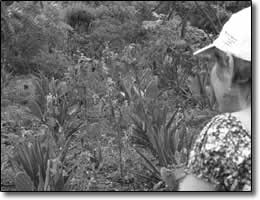
Polyculture in Brazil
by Chef Boy Ari

This is Chef Boy Ari, reporting from the "Sertao," also known as the drylands of central Bahia, Brazil. One might not expect this very hot, very dry place, which might easily be confused with the middle of nowhere, to be perched on the cutting edge of sustainable agriculture, but it is.
The Sertao wasn't always so dry, but when the coastal rainforests were cut, the dry season of the interior grew longer. Meanwhile, the interior forests were cut and burned to make way for agriculture, exposing fragile soil to the elements. The red earth became windswept and sunbaked. But when the rain does come, the still-fertile landscape erupts into a kaleidoscope of green.
These days, much of the green in this region is from castor plants, grown on a commercial scale throughout the Sertao. The castor seeds are pressed for their oil, which is used as an industrial lubricant.
But as with many cash crops, the growers are subject to the whims of a fickle market whose fluctuations can make or break household and regional economies. And by relying solely on one crop, climactic and seasonal abnormalities that hurt the castor crop can also wreak havoc on the Sertao.
Typically, castor plants are planted about 10 feet apart and take three years to fill the empty space between. In the meantime, many farmers plant rows of corn and beans between the castor plants, taking advantage of the space and providing edible and marketable crops to the farmer.
Based on this idea, the Polyculture Project was started, through a collaboration between the castor processing industry and the Bahian Permaculture Institute. The goal of the Polyculture Project is to maximize the biodiversity in the fields and cover as much of the earth as possible by planting a diversity of plants - as many as 23 - in between the castor plants. In addition to the corn and beans, these plots also include cashew, custard apple, tapioca root, cotton, strawberry, mango, passion fruit, sesame and many others whose names you probably wouldn't recognize, such as umbu, a plum-like fruit that is really good with vodka, lime and sugar.
Many of these plants are trees, and when they fill in, the dry fields of yesteryear will be transformed into cool, edible forests. Trees bring water to the ecosystem in several ways. The leaves capture humidity from the air and provide surface for condensation on cool nights. When it does rain, water that might have evaporated away from the system is captured by leaves and roots, and the water that does hit the ground is shaded, and the wind is blocked, so water stays absorbed in the soil.
While visiting the Polyculture Project's fields, I met a man named Jurandir. He is a child of the Sertao, having grown up through the booms and the busts inherent in a monocrop economy. He joined the Polyculture Project because he wants more security for his family than a typical life of castor growing can provide. Today, some of his fields contain polycultures, many of which are several years old. He also has some traditional castor fields planted.
The difference is palpable. The polyculture plots look full and diverse, like a healthy ecosystem, filled with green and with little of the red earth even visible. The conventional plots, meanwhile, look like farms in the desert. With instruments supplied by the Polyculture Project, Jurandir has recorded a six-degree difference in temperature between the polyculture plots and conventionally planted plots. He admits that he doesn't get quite the yield of castor as he used to get with the conventional style, but he is nonetheless convinced that polyculture is the way to go.
"The old way," he says, "the land got worse every year, and farmers had to keep clearing more land. This way, the land gets stronger every year, and we don't need to clear more."
Part of this improvement is due to the fact that many of the polyculture plants are grown as mulch plants, whose sole purpose is to add organic matter to the soil and to cover the soil surface to prevent evaporation.
Ecologists have known for a long time that ecosystems depend on diversity for stability. Gazing at Jurandir's Polyculture fields, you can sense the buzz of life, the fertile chaos of decomposition - the polyculture fields are simply more inviting. His kids prefer to play in them, and gringos come from faraway places to look at them. Like a diversified stock portfolio, the diversity in Jurandir's fields brings economic stability to his family, while his new orchard guarantees fruit for future generations. "Last year," he says, "the price for castor was really bad. But the price for sesame was really good." This diversity also helps spread out the workload, which used to be very busy during certain castor-related periods and extremely slow the rest of the year.
Meanwhile, about 50 beehives collect the nectar from the flowers of his polyculture fields and beyond, producing valuable honey, and his family is spending less than ever on food.
|